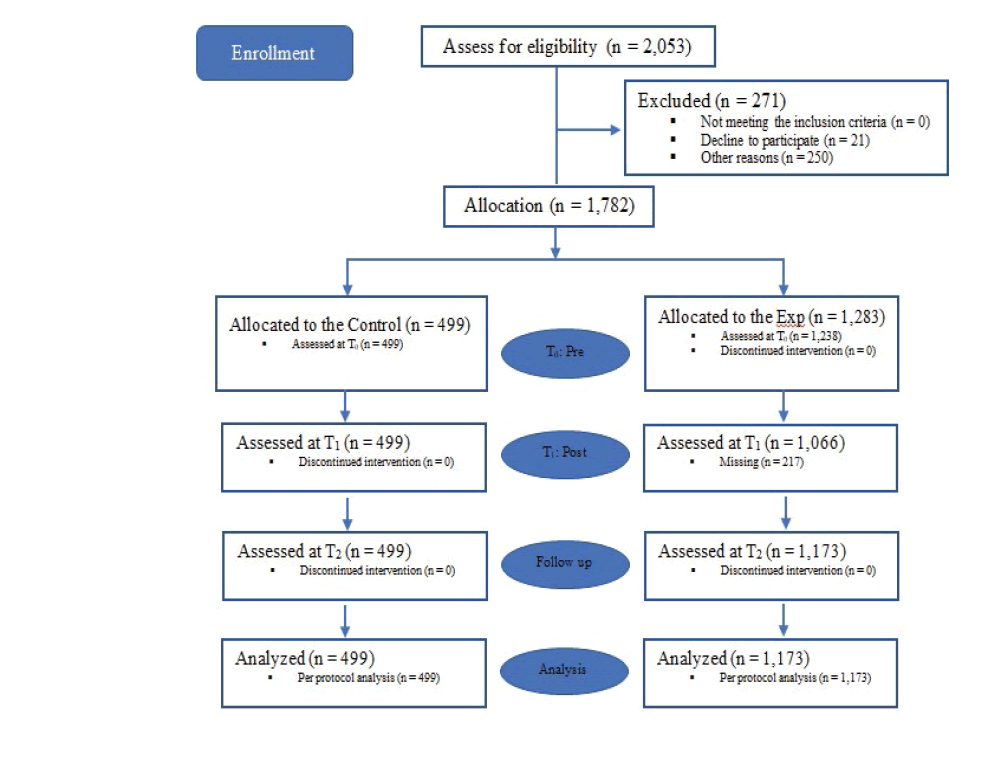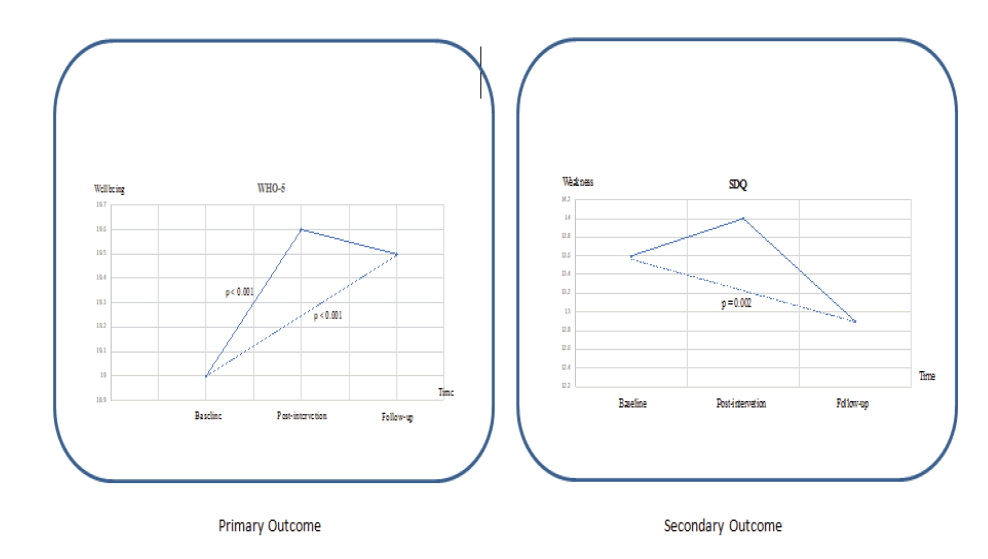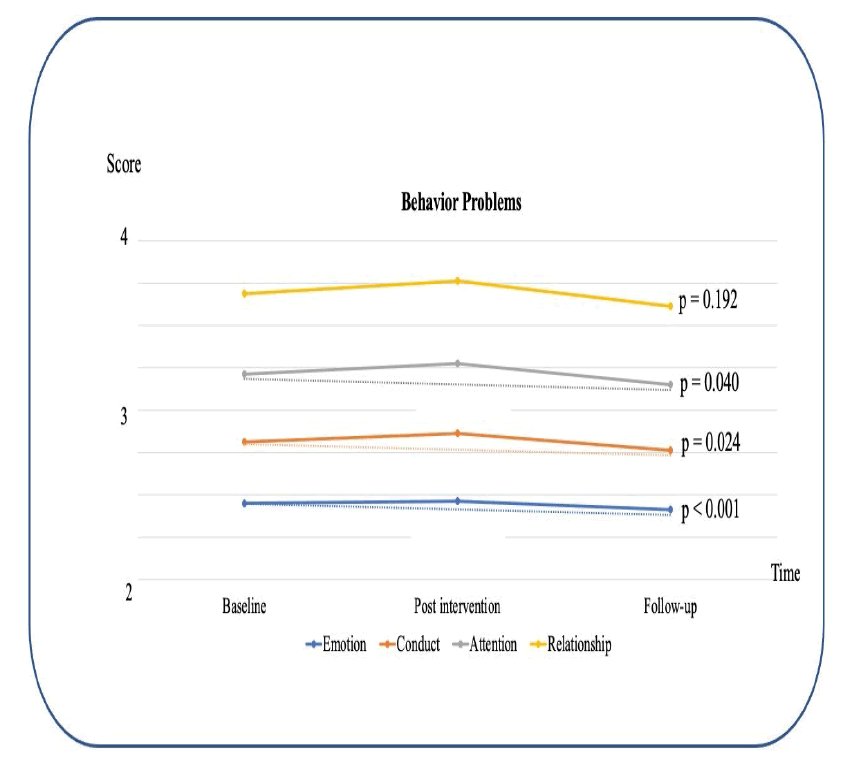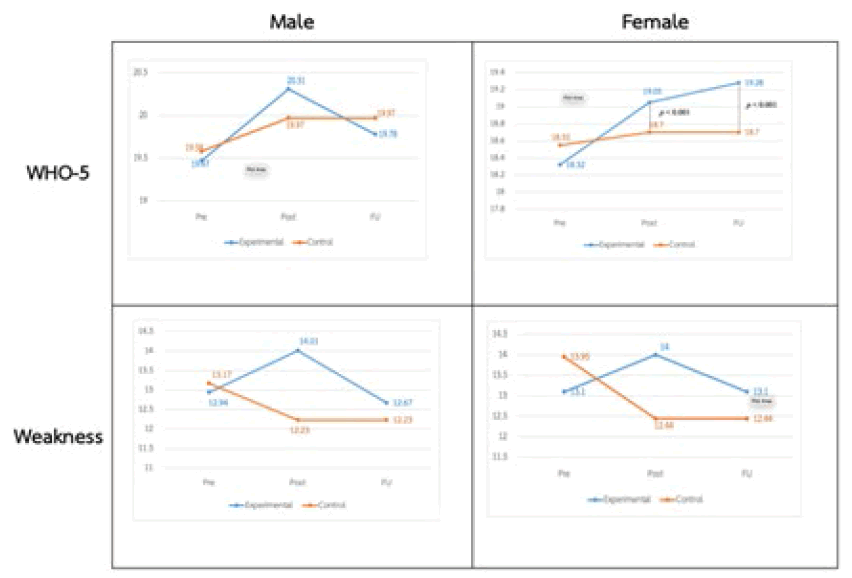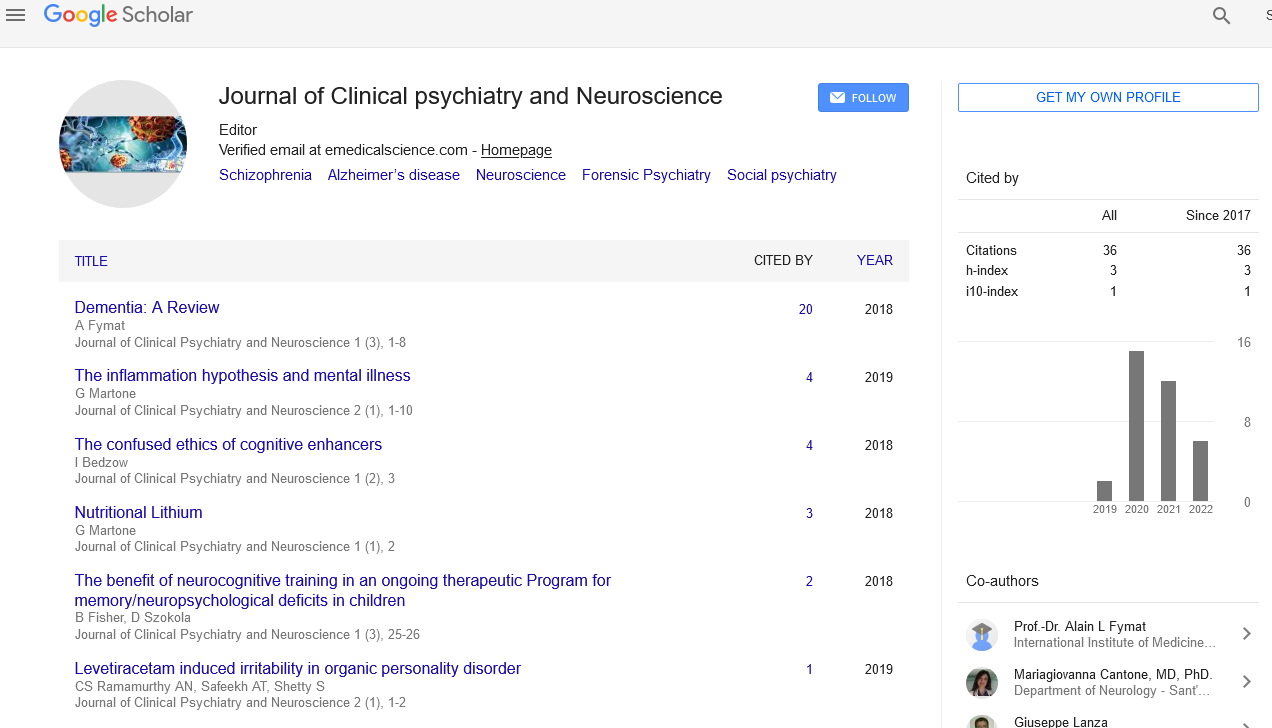Effectiveness of a life skills enhancement program (LSEP-V) for vocational students in Thailand: A quasi-experimental study from a middle-income country
Received: 04-Aug-2022, Manuscript No. PULJCPN-22-5233; Editor assigned: 08-Aug-2022, Pre QC No. PULJCPN-22-5233 (PQ); Accepted Date: Aug 26, 2022; Reviewed: 11-Aug-2022 QC No. PULJCPN-22-5233 (Q); Revised: 13-Aug-2022, Manuscript No. PULJCPN-22-5233 (R); Published: 28-Aug-2022, DOI: 10.37532/puljcpn.2022.5(5).51-7
Citation: Auapisitwong S, Juengsiragulwit D, Mekwilai W, et al. Effectiveness of a life skills enhancement program (LSEP-V) for vocational students in thailand: A quasi-experimental study from a middle-income country. J Clin Psychiatry Neurosci. 2022; 5(5):51-7.
This open-access article is distributed under the terms of the Creative Commons Attribution Non-Commercial License (CC BY-NC) (http://creativecommons.org/licenses/by-nc/4.0/), which permits reuse, distribution and reproduction of the article, provided that the original work is properly cited and the reuse is restricted to noncommercial purposes. For commercial reuse, contact reprints@pulsus.com
Abstract
Background: Adolescence is a complex maturational and developmental process with diverse variation across individuals and cultures, especially among vocational students. However, implanting life skills can help pass through this portal to adulthood, thus resulting in emotional maturity and the mental capacity to deal with the onslaught of life’s challenges. The purpose of this study was to verify the effectiveness of a Life Skills Enhancement Program for Vocational students (LSEP-V) with the aim to increase the level of well-being and strengths, which in turn would reduce behavioral issues for vocational students aged 15-25 years in Thailand.
Methods: Intervention groups from 22 colleges of both lower and higher level students (n = 1,283) received 10 x 45-60-minute ‘LSEP-V’ sessions. The control group was another 13 colleges of vocational students (n = 499) from nearby areas. All participants completed the Five Well-being Index (WHO-5) and Strength and Difficulties Questionnaire (SDQ) at the pre, post, and three-month follow-up periods. Analysis using one-way ANOVA and t-tests was conducted to examine within the group time effect from the pretreatment to the post-treatment and from the post-treatment to the follow-up.
Results: The mean well-being score on the WHO-5 for the intervention group demonstrated a significant difference across the time (p < 0.001). There were increases from the baseline at both the post intervention (95% CI - 0.811 to - 0.283; p < 0.001) and three-month follow-up (95% CI - 0.763 to - 0.257; p < 0.001). The mean weakness score on the SDQ for the intervention group was significantly decreased at the three-month follow-up (95% CI 0.271 to 1.143; p = 0.002).
Conclusions: The effectiveness of the LSEP-V was verified through this study using a quasi-experimental design on a large sample. It showed a medium-term increase in the well-being among the intervention group compared to the control group.
Key Words
Life skills; WHO-5; SDQ; Vocational student; Quasi-experiment; Thailand
Introduction
Adolescence is a unique and formative time in a person’s life. Multiple physical, emotional, and social changes, including exposure to poverty, abuse, or violence, can make adolescents vulnerable to mental health problems. Overall, about 10%-20% of children and adolescents in the world suffer from mental health problems and ill-being [1]. And evidence suggests that some problems are becoming more prevalent among youth [2,3]. In particular, vocational students are considered as a vulnerable group particularly in middle-income countries where the mental health resources are scarce and insufficient (WHO, 2009). With regard to Thailand, vocational students are at a greater risk of mental health conditions, addiction, and violence [4].
As a consequence, promoting psychological well-being and protecting adolescents from behavioral problems and risk factors that may impact their potential to thrive are critical for their well-being during adolescence and for their physical and mental health in adulthood [5].
Mental health promotion and prevention interventions aim to strengthen an individual’s psychological well-being, enhance alternatives to risk-taking behavior, and build life skills for difficult situations and adversities. However, these programs require a multilevel approach with varied delivery platforms; for example, digital media, health or social care settings, schools or the community, and various strategies to reach adolescents, particularly the most vulnerable. Hence, there are three approaches for addressing the mental disorders of children and adolescents: (1) The universal approach, (2) selective approach, and (3) indicated approach [6]. The universal approach is utilized for all people, including those who have no disorder symptoms, while the selective approach targets individuals with specific risks, and the indicated approach is for those with subclinical signs or symptoms [7].
Studies attempting to verify the effectiveness of building psychological well-being and decreasing behavioral problems among children and adolescents have been literally increasing. Several studies have systematically reviewed the effectiveness of various preventive programs and suggested that many universal, selected, and indicated approach programs demonstrate effectiveness with small to medium effect sizes [8-10].
In addition, life skills are important for the promotion of the health and well-being of children and adolescents and to develop knowledge, a positive attitude, and values to lead a healthy life in the future. According to World Health Organization, life skills are abilities for adaptive and positive behavior that enable individuals to deal effectively with the demands, challenges, and stress of everyday life. Childhood and adolescence are also the developmental periods during which one acquires these skills through various methods and people [11].
Therefore, this study had the objective of developing a new life skillsbased promotion program, ‘Life Skill Enhancement Program for Vocational Students (LSEP-V)’, with the aim to increase the psychological well-being and decrease behavioral problems among Thai vocational students.
Goals and Objectives
The aim of this study is to assess the efficacy of a Life Skills Enhancement Program for Vocational Students (LSEP-V) designed to improve student’s well-being and strengths, which would then help to lessen behavioral concerns among vocational students in Thailand between the ages of 15 and 25.
Research Methodology
Study design and participants
This was a universal quasi-experimental study with an intervention and a control group. The intervention group participants received the LSEP-V, and the control group participants received treatment as usual. The intervention group consisted of 1,238 students (15 years-24 years old) attending vocational colleges in Thailand. The control group consisted of 499 students of the same age at other vocational colleges. The research design for this study involved measuring the children’s wellbeing levels as well as strengths and difficulties across three time points during an academic year. The data were collected at the pretest (Time 1; Week 0), post-test (Time 2; immediately after having the intervention), and the follow-up (FU; Time 3; three months following the post-test).
Intervention
Life Skills Enhancement Program for Vocational Students (LSEP-V)
The LSEP-V program included 10 x 45 min-60-min sessions delivered by trained teachers face to face with the group of students. Each session was delivered consecutively or in weekly intervals depending on the context of each school (Table 1). Multiple specific teacher training workshops were held before the commencement of the trial. The fidelity of the program’s delivery was assessed using fidelity assessment items conducted by a trained mental health supervisor. The first module of the program (Sessions 1-3) was dedicated to the development of cognitive skills, the second module (Sessions 4-8) was mainly concerned with emotional skills, and the third module (Sessions 9-10) focused on building social skills.
TABLE 1. Contents of the LSEP-V by session
| Session | Content of the LSEP-V |
|---|---|
| 1 | Understanding individual differences and teamwork |
| 2 | Goal setting and problem-solving |
| 3 | Responsibility and patience |
| 4 | Emotional awareness |
| 5 | Understanding the feelings of oneself and others |
| 6 | Self-exploration |
| 7 | Resolving ‘problems’ and ‘emotions’ |
| 8 | Emotional wounds |
| 9 | Positive communication (I-You message) |
| 10 | Skill of saying ‘NO’ |
Procedure
The 45 min 60 min ‘LSEP-V’ program sessions were conducted in the intervention group over three months from January to March 2019 at a pace of weekly or a consecutive manner although no sessions were held during national holidays.Each session started with an emotional check-in activity. Homework to consolidate the content learned (if any) was given at the end of each session to be worked on at home and returned by the next session.
The actual intervention was conducted by a teacher who attended the threeday training Table 2. To formally assess the program’s fidelity, random program sessions were rated by qualified observers using the nine-item scale of the program’s fidelity measurement tool. The teachers received monthly supervision from local experts who were team members of the program’s development.
TABLE 2 Content of the LSEP-V program training
| Day 1 | Day 2 | Day 3 |
|---|---|---|
| Course aims | Revision & homework feedback | Revision & homework feedback |
| Basic introduction to life skills | Feelings of oneself and others | Emotional wounds |
| Working with differences | Self-exploration | Positive communication |
| Goal setting and problem-solving | Resolving ‘problems’ / ‘emotions’ | Skill of saying ‘NO’ |
| Responsibility and patience | Case study | Micro teaching |
| Emotional awareness | Supervision | Supervision |
| Homework | Homework | Course evaluation |
Measurements
Primary outcome measure
The primary outcome measure was the World Health Organization’s Five Well-Being Index (WHO-5), a short self-reported measure of current mental well-being. The measure was first introduced in its present form in 1998 by the WHO Regional Office in Europe as part of the DEPCARE project on well-being measures in primary healthcare. The WHO-5 was found to have adequate validity in screening for measuring outcomes in clinical trials. Item response theory analyses in studies of younger persons and elderly persons indicated that the measure had good construct validity as a unidimensional scale measuring the well-being in these populations. The WHO-5 consisted of five statements, which the respondents rated according to the scale (in relation to the past two weeks) ranging from at no time=0 to all of the time=5. The total raw score, ranging from 0 to 25. The WHO-5 demonstrated excellent internal consistency and good criteria validity. Internal consistency (Cronbach’s α) in the present sample was good (α=0.86) [12].
Secondary outcome measure
The secondary outcome measure was the self-report version of the Strengths and Difficulties Questionnaire (SDQ) developed by Goodman [13]. The SDQ included 25 items with the score=0 (not true), 1 (somewhat), or 2 (certainly true) according to the perceived severity of the symptom. The items were divided into five subcategories: emotion symptoms, behavioral problems, hyperactivity/inattention, peer relationship problems, and prosocial behavior. A total difficulty score computed by totaling the score of the first four subcategories, and the maximum possible score was 40.
Statistical analysis
The statistical analysis and reporting of this trial were conducted in accordance with the Consolidated Standards of Reporting Trials (CONSORT) guidelines with the primary analyses based on the Per-Protocol (PP) principle. For the baseline variables, a summary of the statistics was constructed using the frequencies and proportions for the categorical data, mean, and Standard Deviation (SD) for the continuous variables. The participants’ characteristics were compared using Chi squared tests for the sociodemographic differences, education level, study program, and t-tests were utilized for the baseline score differences Statistical analysis between the intervention and control groups. The primary and secondary outcomes were analyzed by using ANOVA and an independent t-test to identify the within group difference from the pretest to the post-test and the post-test to the follow-up period.
Results
Study population
The participants’ characteristics are summarized in Table 3. Out of 2,053 eligible students, only 1,672 (81.14%) completed the experiment. Sociodemographicbased differences at the baseline were examined with Chi-square tests between the 1,283 members of the experimental group and 499 members of the control group. Then, the group’s differences at the baseline were compared, and a t-test was conducted of the pretest of the WHO-5 and SDQ scores. There were no significant differences of the WHO-5 scores between the two groups (p=0.800), while the SDQ weakness scores were significantly different (p=0.035).
TABLE 3 Participants’ characteristics at the baseline
| Characteristics | N | Exp. Group | Control Group | p | |
|---|---|---|---|---|---|
| (n = 1,283) | (n = 499) | ||||
| Age; mean (SD) | 1,614 | 18.6(1.7) | 19.0(1.7) | <0.001b | |
| Gender, n (%) | Male | 824 | 583(65.3) | 286(34.7) | <0.001a |
| Female | 913 | 700(76.7) | 213(23.3) | ||
| Education level; n (%) | Lower | 672 | 507(75.4) | 165(24.6) | <0.001a |
| Upper | 942 | 627(71.3) | 315(28.7) | ||
| Study program; n (%) | Sciences | 1,287 | 885(68.8) | 402(31.2) | <0.001a |
| Arts | 495 | 398(80.4) | 97(19.6) | ||
| Region; n (%) | Urban | 120 | 40(33.3) | 80(66.7) | <0.001a |
| Non-urban | 1,662 | 1,243(74.8) | 419(25.2) | ||
| Well-being; mean (SD) | 1,782 | 19.0(3.3) | 19.0(3.1) | 0.800b | |
| Strength; mean (SD) | 1,782 | 7.1(1.9) | 6.9(2.0) | 0.158b | |
| Weakness; mean (SD) | 1,782 | 13.6(5.2) | 13.0(5.3) | 0.035b | |
| Emotion problem; mean (SD) | 1,782 | 3.6(2.1) | 3.4(2.0) | 0.017b | |
| Conduct problem; mean (SD) | 1,782 | 2.9(1.6) | 2.8(1.7) | 0.069b | |
| Attention problem; mean (SD) | 1,782 | 3.2(1.8) | 3.1(1.8) | 0.219b | |
| Relationship problem; mean (SD) | 1,782 | 7.1(1.9) | 6.9(2.0) | 0.518b | |
| Note: ap-value for Chi-square test; bp-value for the independent t-test. | |||||
All 10 sessions were held in the classroom or at a short camp during the regular semester. Self-reported questionnaires were distributed to the students by the teacher in charge of each class via an online platform (Google Forms). The data count was reduced by 271 because some students declined to participate Figure 1.
The intervention group’s well-being score was higher than the control group at the post-test and follow-up (19.60 vs 19.43 and 19.53 vs 19.43, respectively), without statistical significance. Similarly, weakness and other behavioral problems showed no significant difference between the two groups by using the students’t-test.
After having the intervention (the post-test), the experimental group demonstrated a significantly higher mean score of the WHO-5 (pretest=19.0 and posttest=19.6; 95% CI 0.811 to 0.283; p<0.001). However, there was no significant decrease in the SDQ total mean score nor any other behavioral problems Table 4 and Figure 2 and 3.
TABLE 4. Mean and standard deviation of the primary outcomes of the experimental group and control group
|
Outcomes |
Group | Visit, Mean (SD) | F | ||
|---|---|---|---|---|---|
| Baseline | Post | Follow-up | (p-value) | ||
|
WHO-5 |
Intervention | 18.98(3.1) | 19.60(3.2) | 19.53(3.1) | 14.25(<0.001) |
| Control | 19.02(3.2) | 19.43(3.1) | 19.43(3.1) | 2.47(0.014) | |
|
Well-being |
t (p-value) | 0.06(0.805) | 0.69(0.405) | 0.45(0.322) | |
|
SDQ |
Intervention | 7.10(2.0) | 6.90(2.2) | 7.08(2.1) | 5.24(0.005) |
| Control | 7.07(1.9) | 7.00(2.1) | 7.00(2.1) | 1.10(0.273) | |
|
Strength |
t (p-value) | 1.99(0.158) | 2.02(0.155) | 2.01(0.114) | |
|
SDQ |
Intervention | 13.60(5.2) | 14.00(5.9) | 12.88(5.9) | 4.20(0.015) |
| Control | 13.01(5.3) | 12.32(5.6) | 12.32(5.6) | 4.43(<0.001) | |
|
Weakness |
t (p-value) | 4.43(0.035) | 28.82(<0.001) | 5.17(0.047) | |
|
SDQ emotion |
Intervention | 3.38(2.0) | 3.72(2.2) | 3.31(2.2) | 5.00(0.002) |
| Control | 3.64(2.1) | 3.09(2.2) | 3.09(2.2) | 4.99(<0.001) | |
|
Problem |
t (p-value) | 5.75(0.017) | 29.32(<0.001) | 7.13(0.025) | |
|
SDQ conduct |
Intervention | 2.95(1.6) | 3.15(1.8) | 2.79(1.7) | 6.31(0.002) |
| Control | 2.79(1.7) | 2.77(1.6) | 2.77(1.6) | 2.12(0.035) | |
|
Problem |
t (p-value) | 3.30(0.069) | 16.81(<0.001) | 7.23(0.518) | |
|
SDQ attention |
Intervention | 3.22(1.8) | 3.28(2.0) | 3.06(1.9) | 1.50(0.222) |
| Control | 3.10(1.83) | 2.86(1.8) | 2.86(1.8) | 3.80(<0.001) | |
|
Problem |
t (p-value) | 1.51(0.219) | 16.59(<0.001) | 10.68(0.014) | |
|
SDQ relationship |
Intervention | 3.73(1.4) | 3.85(1.5) | 3.70(1.5) | 0.83(0.440) |
| Control | 3.78(1.5) | 3.60(1.5) | 3.60(1.5) | 2.30(0.022) | |
|
Problem |
t (p-value) | 0.42(0.518) | 9.48(0.002) | 6.55(0.091) | |
|
t = independent t-test for the groups’ differences; F = one-way ANOVA for within the groups’ (baseline, post, and follow-up) differences. |
|||||
Showing the same pattern Table 5, the mean score of the WHO-5 after three months from the post-test (the follow-up) was 19.5, which was significantly higher than the baseline (95% CI -0.763 to 0.257; p<0.001). However, the within group differences demonstrated a significant decrease at the follow-up from the baseline of the SDQ scores; total weakness (mean=12.9; 95% CI 0.271 to 1.143; p=0.002) emotion problem (mean=3.3; 95% CI 0.155 to 0.494; p<0.001), conduct problem (mean=2.8; 95% CI 0.020 to 0.281; p=0.024), and attention problem (mean=3.1; 95% CI 0.007 to 0.303; p=0.040).
TABLE 5. Mean and standard deviation of the outcomes of the intervention group at the baseline and post-intervention
|
Outcomes |
Baseline | Post | 95% CI | p | |||
|---|---|---|---|---|---|---|---|
| Mean | SD | Mean | SD | Lower | Upper | ||
|
Well-being |
19 | 3.1 | 19.6 | 3.2 | -0.811 | -0.283 | <0.001 |
|
Strength |
7.1 | 1.9 | 6.9 | 2.2 | 0.111 | 0.444 | 0.001 |
|
Weakness |
13.6 | 5.2 | 14 | 5.9 | -0.867 | 0.043 | 0.076 |
|
Emotion problem |
3.6 | 2.1 | 3.7 | 2.2 | -0.251 | 0.097 | 0.385 |
|
Conduct problem |
2.9 | 1.6 | 3.2 | 2 | -0.34 | -0.066 | 0.004 |
|
Attention problem |
3.2 | 1.8 | 3.3 | 2 | -0.216 | 0.092 | 0.433 |
|
Relationship problem |
3.8 | 1.5 | 3.9 | 1.5 | -0.194 | 0.053 | 0.264 |
|
Note: p-value for the independent t-test; n for the baseline = 1,782; n for the post-test = 1,565. |
|||||||
Discussion
This was an implementation study of the Life Skills Enhancement Program for Vocational Students (LSEP-V) in vocational colleges in Thailand with the purpose of verifying the effectiveness of the LSEP-V with the aim to increase the level of well-being and strengths, which in turn would reduce the behavior-related problems with a universal approach in Thai vocational colleges. The results of this study indicated that in the intervention group, the well-being scores by the WHO-5 were significantly increased, while the weakness scores by the SDQ were significantly decreased. Although there were no significant differences between the intervention and control groups during the medium-term follow-up, the effectiveness of this program using a universal approach was verified through this study using a quasi-experimental design on a large sample.
In addition, currently, several programs for increasing children and adolescents’ psychological well-being are being developed based on the universal approach in a school class; however, it has been pointed out that although the effectiveness of the well-being promotion programs has been proven to a degree, the effectiveness of the behavioral problems prevention programs remain questionable.
Therefore, there were 4 possible observations for discussion. Firstly, the baseline characteristics of the students differed significantly in both the intervention and control groups, including age, gender, study level, and type of study program. Gender was believed to be a significant moderator affecting the outcome of the life skills promoting program. The sub-analysis from this study showed that female students in the intervention group were more likely to have higher well-being than those in the control group at the post-intervention and follow-up periods (p<.001) Figure 4. This was further relevant to the study of critical review that mentioned the efficacy of intervention decreased with the increasing proportion of female participants in an RCT [14].
Secondly, the implementation process was the key for the desirable outcome of the program. LSEP-V provided 10 free-standing lessons for a universal setting in a vocational college class. The challenges were the quality of the implementation influenced by how prepared the colleges were when they adopted the LSEP-V. Moreover, the training of the teachers and training support from the supervisors became the critical factors for the program’s success. More than half of the colleges delivered LSEP-V in a consecutive manner during a two-day camp rather than weekly lessons. As a consequence, this format of delivery may reduce the frequency of the program sessions and shorten the amount of the active ingredients. Thirdly, the usage of the SDQ as a secondary outcome measure to evaluate the adolescent’s behavioral problems by self-administration had the probability of under-reporting the behavior index. Similar results were found in India, where the SDQ did not show any differences between the experimental and control groups; however, the teachers’ observation revealed positive changes in the behavior among the students. The fourth explanation referred to the treatment as usual in control group. The other 13 colleges where students did not receive the LSEP-V obtained various activities organized by each college. The influence of the routine activities in the control group might also confound the effect of the LSEP-V, or it possibly resulted in a comparable outcome among the students.
Limitations and Future Research
There were several limitations in this study. Firstly, a random assignment method was not applied to both the intervention and control groups. When the pre-program scores were compared, the adolescents of the intervention group showed significantly higher SDQ weakness scores. The reason for this imbalance was unclear, but it surely resulted from not using a random assignment method. This may have been because of the utilization of the independent t-test method to analyze the change of each score from the baseline to the post-intervention and the baseline to the follow-up without considering a repeated measure method like repeated ANOVA. Moreover, it would be more appropriate to randomize the sample before the intervention and start the statistical analysis from an equalized baseline. The second limitation of this study related to the measurement scales. This program used selfadministered questionnaires from the students. As such, the single respondent might be unable to demonstrate the differences of the behavior domain. However, the purpose of the Life Skills Enhancement Program for Vocational Students (LSEP-V) was to prevent behavior-related problems and verify the program’s effectiveness. Hence, it was essential to include the observation from the teachers, friends, or family as an indicator of change in behavior.
To evaluate the effectiveness of this program, it would be advisable not only to apply an RCT design, but also to continuously confirm its long-term effectiveness with longitudinal studies using school achievement and dropout rate as a measurement in Thailand.
Conclusion
The result of this study confirmed the effectiveness of Life Skills Enhancement Program for Vocational Students (LSEP-V) by promoting the level of wellbeing, which in turn reduced behavior-related problems at vocational schools in Thailand. In this study, it should be noted that it would be quite important that this program could be implemented in actual school classes as a part of the regular sessions. Nevertheless, simultaneously, there were several limitations in the study’s design, so it would be necessary to apply cluster randomization methods and to verify the preventive effects in a vertically integrated manner in the future.
References
- Henderson JL, Cheung A, Cleverley K, et al. Integrated collaborative care teams to enhance service delivery to youth with mental health and substance use challenges: protocol for a pragmatic randomised controlled trial. BMJ open. 2017;7(2):014080.
- Kieling, C.“Child and adolescent mental health worldwide: Evidence for action”. Lancet. 378(9801), 1515-25,
- Choi A. Emotional well-being of children and adolescents: Recent trends and relevant factors.
- Assanangkornchai S, Li J, McNeil E, et al. Clusters of alcohol and drug use and other health-risk behaviors among Thai secondary school students: a latent class analysis. BMC public health. 2018;18(1):1-10.
- Kessler RC, Angermeyer M, Anthony JC, et al. Lifetime prevalence and age-of-onset distributions of mental disorders in the World Health Organization's World Mental Health Survey Initiative. World psychiatry. 2007;6(3):168.
- Haggerty RJ, Mrazek PJ. Reducing risks for mental disorders: Front prev interv res.
- Horowitz, J. L., Garber, J. The prevention of depressive symptoms in children and adolescents: A meta-analytic review. J consult clin psychol. 74(3), 401.
- Mekala CV, Aras R, Devadason JM. Effectiveness of behavioral change communication (Bcc) on life skills (Ls) for youth. Indian J Appl Res. 2015;5(4):631-33.
- Srikala B, Kishore KK. Empowering adolescents with life skills education in schools–School mental health program: Does it work?. Indian J psychiatry. 2010;52(4):344.
- Tiwari P, Naik PR, Nirgude AS, et al. Effectiveness of life skills health education program: A quasi-experimental study among school students of South India. J Educ Health Promot. 2020;9.
- World Health Organ. Division of mental health and prevention of substance abuse. WHOQOL and spirituality, religiousness and personal beliefs (SRPB). World Health Organ. 1997.
- Topp CW, Østergaard SD, Søndergaard S, et al. The WHO-5 Well-Being Index: a systematic review of the literature. Psychother psychosom. 2015;84(3):167-76.
- Goodman, R., Meltzer, H., Bailey, V. The Strengths and Difficulties Questionnaire: a pilot study on the validity of the self-report version. Eur child adolesc psychiatry. 7(3), 125-30.
- Singla S, Jhamb S, Singh KD, et al. Depression affects autonomic system of the body? Yes, it does!. J educ health promot. 2020;9.




